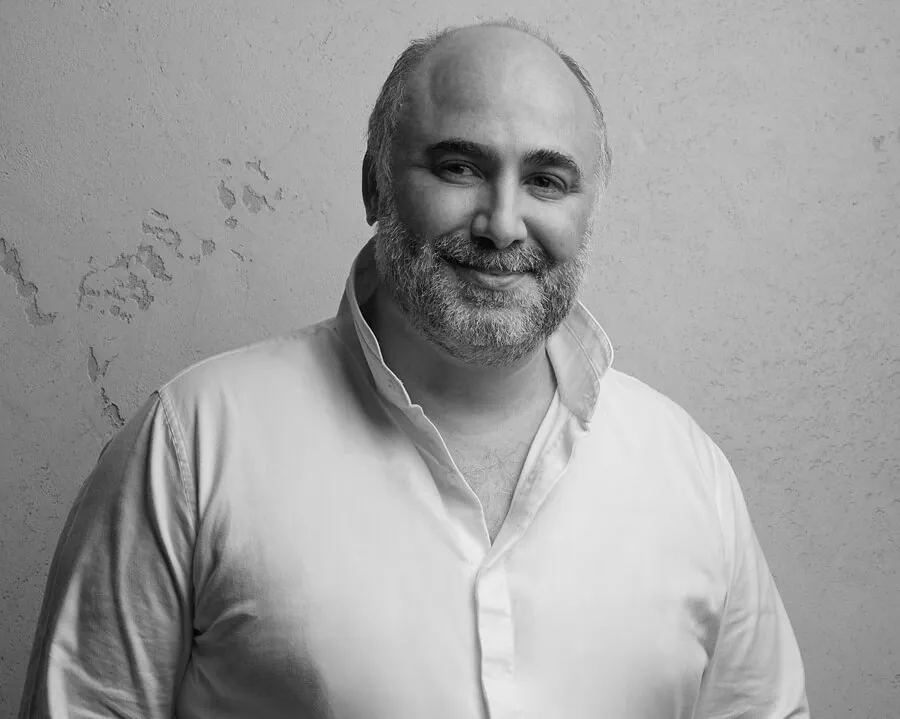
Galeon, founded in Gdansk in 1982, has a global reputation for its wide variety of motoryachts ranging in overall length from 33-83ft. Over the past decade or so, the Polish builder’s Fly (flybridge), Skydeck (sportsbridge) and GTO/GTI (Grand Touring Outboard/Inboard) lines have impressed with pioneering innovations such as dropdown sides, waterside bars and forward saloon doors.
The shipyard’s collaboration with In Situ & Partners began when Galeon’s leadership was in Hong Kong and sought a fresh design perspective. A meeting was arranged with Yacine Bensalem, In Situ’s Principal and Founding Partner. Galeon was particularly interested in the studio’s extensive expertise in luxury and high-end design for top-tier hospitality, commercial and residential projects, valuing their outside perspective from the yachting world.
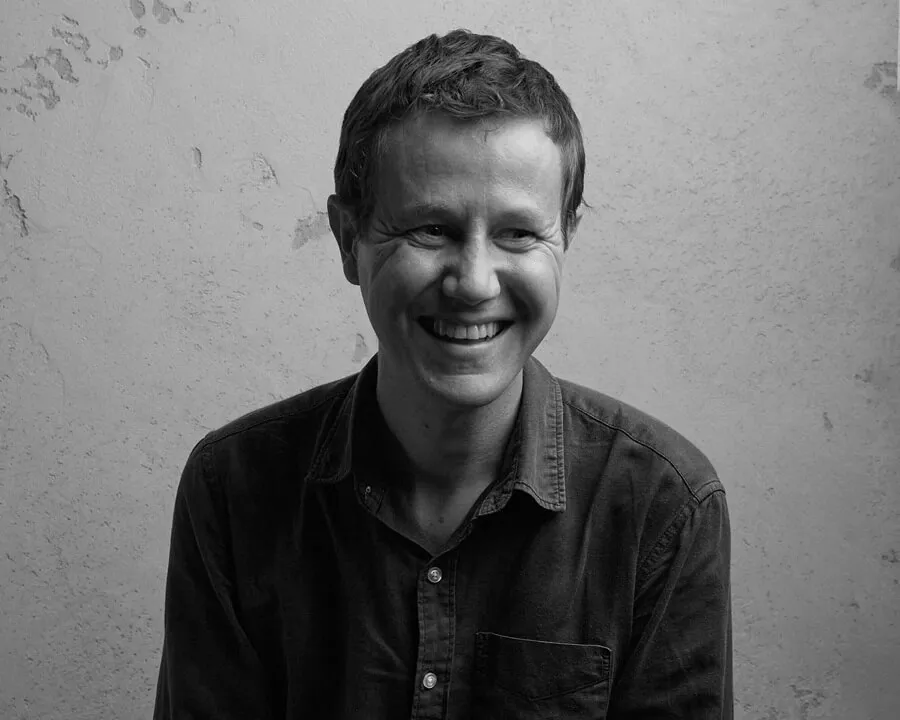
A partnership was swiftly formed, with the project leadership assigned to Philippe Grasset, the studio’s Interior Design Director, a French designer whose aesthetic has been shaped by years living and working in Japan and Hong Kong.
This international mindset is at the core of In Situ’s identity. The studio is a cultural melting pot, a Hong Kong-based company with a global team that delivers designs for a local and worldwide clientele.
This ethos is personified by Bensalem, who was born in Algeria with Bulgarian heritage, grew up in Milan, and studied architecture in Paris. His professional journey, which included living and working in Brussels and Singapore before establishing himself in Hong Kong in 2007, reflects a deeply global outlook.
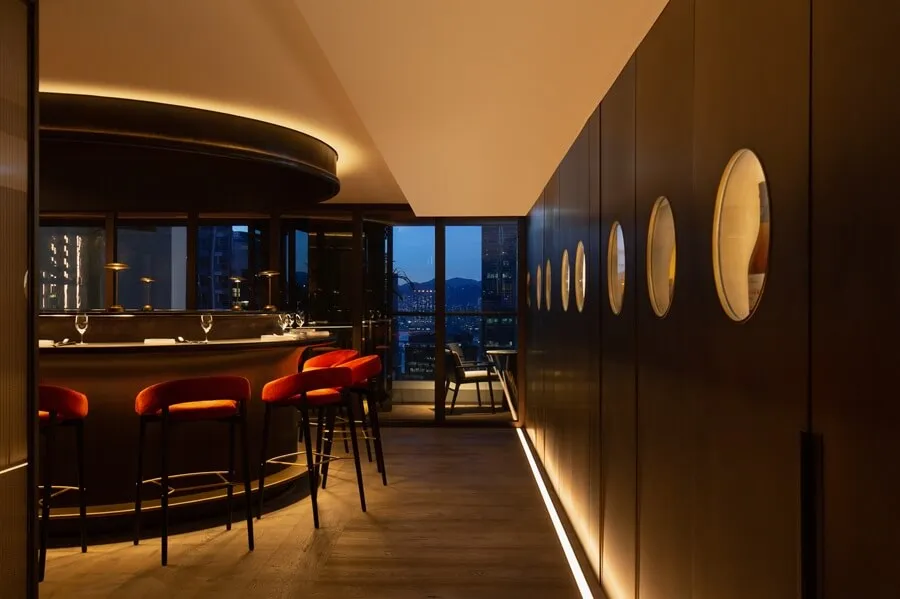
The diverse backgrounds of the team – including key designers Pietro Peciccia (Italian and German heritage), Frederic Nouvel (French with Polish and Spanish heritage) and Terri Yau (Australian Chinese designer with Hong Kong heritage) – were an ideal fit for Galeon’s global market ambitions.
The 640 Fly was your first Galeon model. What was your brief, when did it launch and what have been some highlights of the working process?
Bensalem: That first meeting with Jacek was a very open conversation. I explained that we had no experience in yachting. I had helped people with some fit-outs and styling on existing yachts but that was not redesigning a whole yacht [interior].
Jacek said Galeon had enough in-house technical and design resources to guide us and fill the gaps in our knowledge. He was looking for designers with an international vision who could understand different markets, particularly China and Asia, as well as Europe and North America, which are Galeon’s main targets.
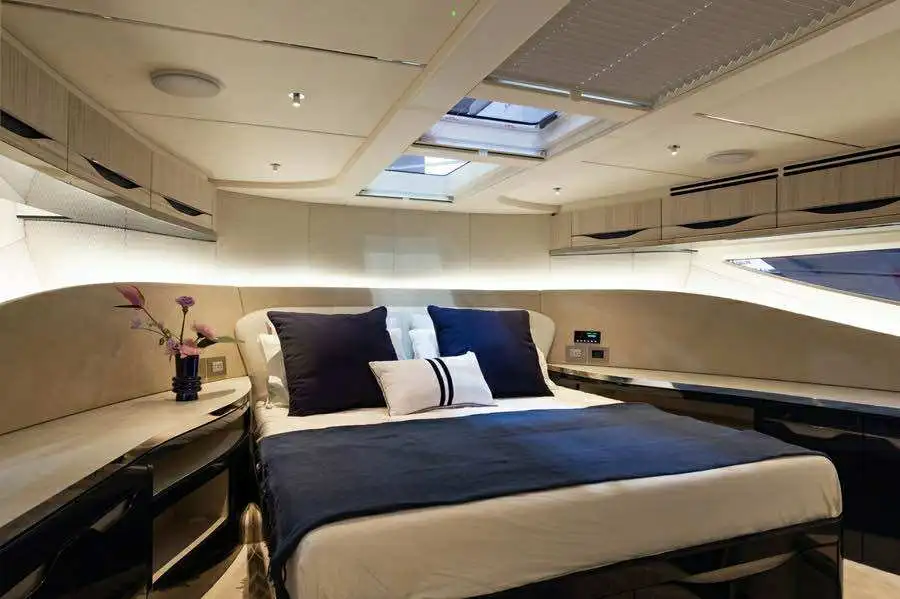
He needed people who could understand and federate these three markets through design, perhaps with different palettes, and who understood the luxury markets and expectations of ultra-high-net-worth individuals.
After our discussion, he felt we had this understanding and that we could be the right company for the job. I immediately knew Philippe, our Design Director, was the perfect person to lead this exciting new challenge. It also helped that we get things done very quickly in Asia. Hong Kong’s efficiency, combined with our international exposure, would all be a good fit.
Galeon gave us a fairly free hand. Our plan was to reinterpret traditional boat design codes in a more contemporary fashion. Our ingredients would be high-gloss marine lacquers, mirror stainless steel, walnut and teak wood. The lines we created are very contemporary, with curves, intricate junction details, shadow gaps and invisible light sources, more commonly found in luxury retail or homes rather than in boating design.
We had weekly meetings with their design department starting June 2024, and our first redesigned Galeon interior, the 640 Fly, was presented at Boot Düsseldorf in January this year.

Grasset: Yes, and we have completed six designs including five from the Fly series: the 640, followed by the 620 then three more. More recently, we’ve done the 570 Sky, which looks sportier, and there will be more Skydeck models to come.
We’ve just started on the smaller GTO/GTI dayboat series, which is quite sporty and party style. For the upcoming model, we are aiming to make it more colourful and joyful. The Fly series now has five different interior options, the Skydeck line has three, and we are working on design options for the GTO/GTI.
What truly distinguishes Galeon in the European market is its fully integrated, in-house production. Unlike many historically established yards that rely on subcontractors, Galeon employs 1,600 professionals across two large manufacturing facilities, and operates dedicated internal workshops for metalwork, woodworking, glass, leather and upholstery.
We recognised early that the shipyard’s philosophy was to showcase this master craftsmanship, often by artfully combining materials like wood, metal and leather.
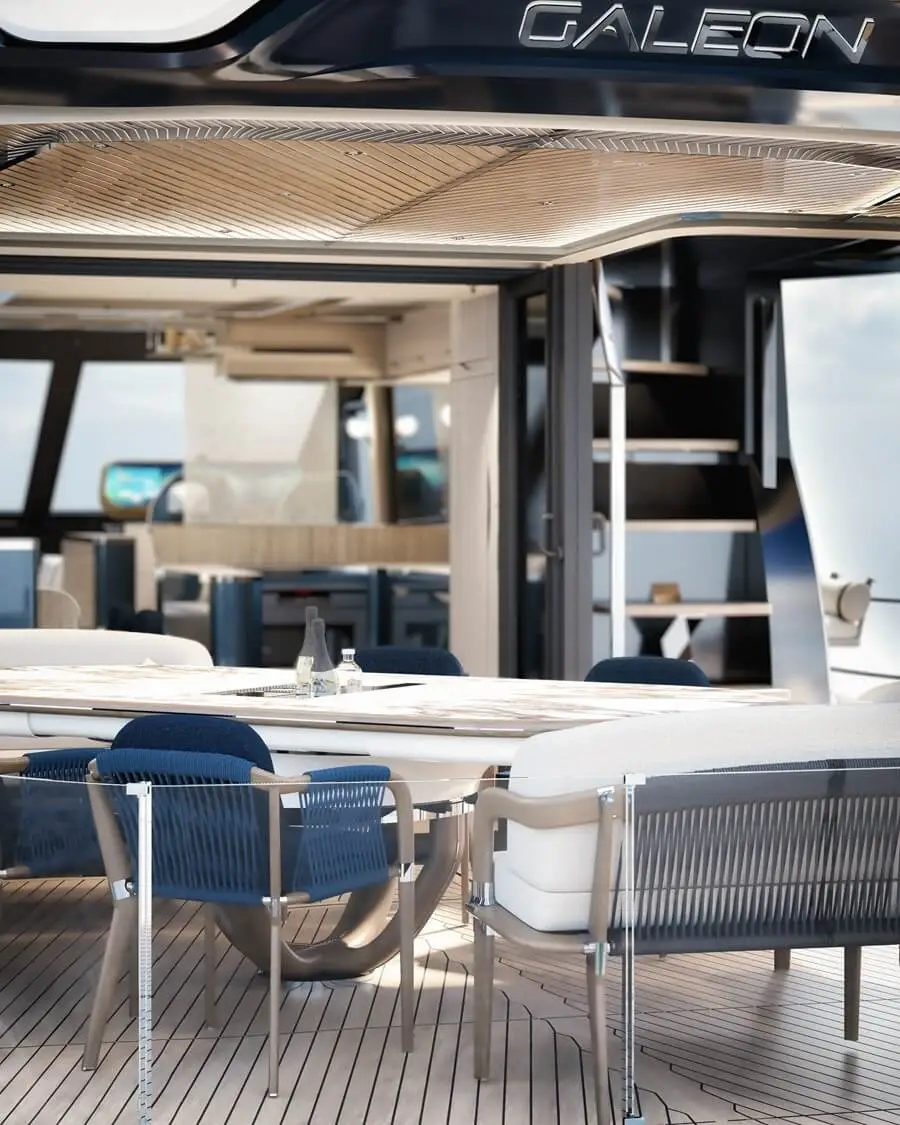
Bensalem: This point Philippe makes is a very important competitive advantage for Galeon. Subcontracting these crafts would incur astronomical costs. Because it’s done in-house, it can be coordinated perfectly as all the trades are in the same facility. This makes coordination possible and allows for certain impressive details to be achieved at a very reasonable price.
Have your interior commissions for Galeon included any discussions with their naval architecture and exterior design collaborators, UK-based Tony Castro Yacht Design or Roberto Curtò’s Italy-based RC Design?
Bensalem: Not really. We’re working directly with the Galeon design team. But it’s interesting that although Galeon is a Polish shipbuilder that started during the communist era, it has become very open to the world, now using a Southampton-based Portuguese naval architect, Tony Castro, and a Hong Kong-based international company for interior design.
As Galeon models were your studio’s first full yacht interiors, what could you draw from in terms of commercial, club and residential spaces that In Situ has designed, besides the lighting you mentioned earlier?
Bensalem: There was quite a lot we could draw upon. As Philippe noted, Galeon possesses remarkable in-house artisanal know-how and craftsmanship, which is something we always strive to highlight in our projects, whether it’s a restaurant, residence or now a yacht.
We deeply enjoy creating designs that celebrate skilled workmanship. This often means combining materials in unexpected ways and incorporating intricate details that elevate the entire space. That philosophy translated very naturally to the yacht interiors.
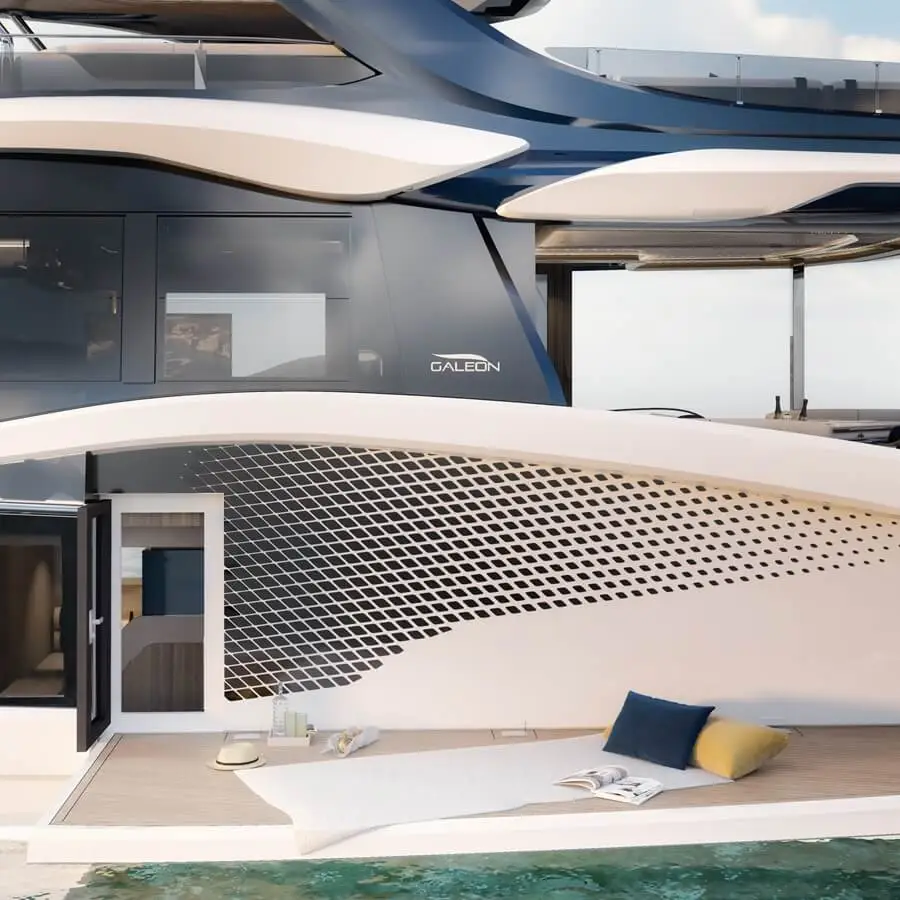
Grasset: And there was a learning curve on ergonomics. For hospitality or residential projects, we always consider dimensions for comfort and reach. On a yacht, with its tighter environment, we still try to bring those comforts that we are used to implementing in other environments.
What other yacht-specific aspects has In Situ had to address in the interior, considering objects on board move when underway, materials need to hold up to saline, sometimes wet conditions, and other challenges changing from on-land to on-water design?
Grasset: We received invaluable support from Galeon’s in-house team on these practical challenges. They were essential in vetting our material choices, advising against those that couldn’t withstand the marine environment. This guidance was constructive. They introduced us to a range of suitable, high-performance alternatives including impressive synthetic materials that are exceptionally durable without compromising on style.
How would you describe differences between In Situ’s designs for new Fly models compared to the series’ previous interiors?
Grasset: I’m proud of them all, especially the first two we did – the 640 Fly and 620 Fly. After these models, our work was about finding ways to simplify smaller vessels and speed up the execution while keeping the spirit of these two initial yachts.
Bensalem: Yes, the 640 Fly and 620 Fly were really breakthrough moments.
Grasset: Then, when we moved to the 570 Sky, we began looking for design consistencies we could use across the different series.

When is the 570 Sky expected to launch?
Grasset: The 570 Sky is on track to be completed by the end of the year, with the intention for it to be presented at the Boot Düsseldorf show.
So far, across models, have there been any differences to interiors designed for use in the Asia-Pacific compared to models sold in Europe and North America?
Bensalem: There are options aimed at the American market: a larger fridge, a very substantial barbecue area and more TVs, seating and lounging areas where possible. We haven’t had a similar brief for Asia-Pacific.
Grasset: We expect Asia-Pacific and Europe to share similar aesthetics and interior arrangements.
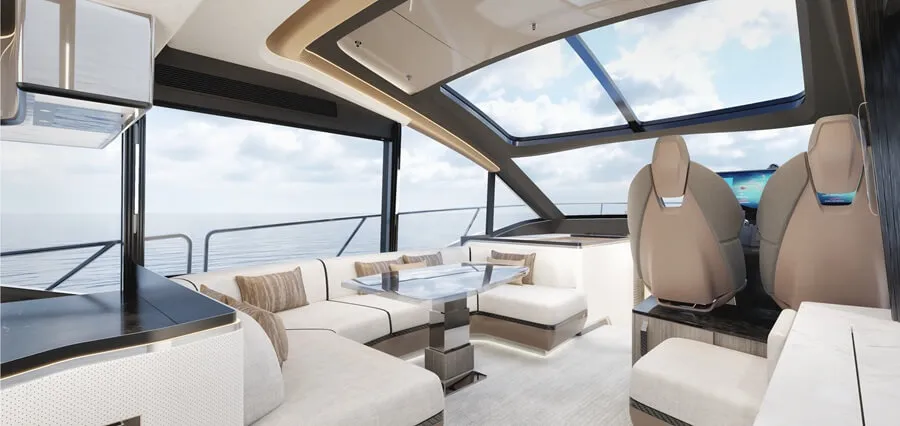
Has this collaboration with Galeon inspired In Situ to diversify further in the realms of interior design – for instance, into the cruise ship, automotive or other sectors?
Bensalem: In a short period, we’ve managed to produce six new designs. We’d like to design more boats. An end-user for a custom superyacht would be very interesting. With more space, it might even be easier than designing for a smaller yacht. Private jets and luxury trains would also be interesting areas to explore.
For more information visit insituandpartners.com, galeon.pl, asiamarine.com
This article was first seen on YACHT STYLE
For more on the latest in luxury yachting reads, click here.
